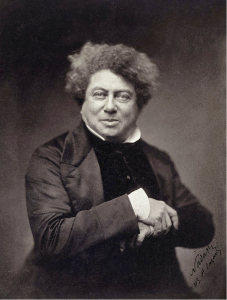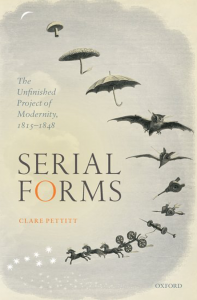By Clare Pettitt, Professor of Nineteenth-Century Literature and Culture at King’s College London
The 5th of June 1846 was a boiling hot day. It was so hot that Elizabeth Barrett, soon to become Elizabeth Barrett Browning, ‘could do nothing but lie on the sofa and drink lemonade and read Monte Cristo’. She wrote to Robert Browning that she had started ‘“Le Comte de Monte Cristo,” the new book by Dumas, (observe how I waste my time . . .) & really he amuses me . . . six volumes I am glad to see.’ She was not alone: Dumas’s newspaper novel, The Count of Monte Cristo, was everywhere that year. It was running in various languages in serial magazines and abridged in the cheap penny papers across Europe and America. Ralph Waldo Emerson remembered “falling back” on long serial novels by Dumas and Dickens on his voyage to Europe from America in 1847. Dickens’s new novel Dombey and Son was coming out between October 1846 and April 1848 and was eagerly consumed by the literate and semi-literate alike. In the 1840s, then, the print serial had begun to cross languages, countries, classes, and genders. The form was creating new international readerships and a new rhythm of reading.

When they think about seriality, most literary scholars think about serialized fiction. But my new book, Serial Forms: The Unfinished Project of Modernity, 1815-1848, sets out to enlarge our thinking about seriality by starting to think about it as not just a literary, but also a political, historical and social category. Seriality offered a century that was already on the move a way of modelling movement. Ultimately, I suggest that seriality is the defining form of modernity. The majority of work on seriality has focused on the twentieth century, in a context of advanced political and industrial standardization, a mass society, and state-sanctioned violence on an unprecedented scale. The Second World War produced a dark and terrible version of seriality in Europe.
The theories of seriality that emerged from the Frankfurt School after the war are understandably culturally pessimistic about what Adorno called ‘the culture industry’, which figures a manipulative mass media using repetition and reproduction to maximize the authority of governments and markets and to undermine attempts at social resistance, collectivity, or finally even subjectivity. Much of the twentieth-century work on seriality is broadly Marxist in its identification of seriality with capitalism, through Fordism, for example, or through consumption patterns and the accelerated rhythms of fashion. In cultural criticism today, seriality is most often described as the cultural logic which drives neoliberalism in its tireless accrual of information and its relentless agglomeration of power. Serial systems have adapted well to neoliberalism’s requirements for built-in flexibility, risk-taking, and mobility. The digital series of computer programming has replaced the factory assembly line as the material actualization of serial logic, and the ubiquity of computer code means that we find ourselves more serialized today than ever before.

But in Serial Forms I focus on the period before a mass society and mass communication existed. I ask what the history of modern ‘seriality’ might be, and how emergent theories of history and time entered into the practice of everyday life in the nineteenth century in ways which would later support the development of a culture of ‘seriality’. Although the book has been informed by theories of seriality, it largely relies on historical and literary evidence to construct its argument. I set out to show that in the early nineteenth century, seriality becomes a kind of knowledge, a knowledge that is political, bodily and historical: a knowledge about being in time.
In his 1980 lecture ‘Modernity: An Unfinished Project’, Jürgen Habermas declared that, ‘[w]e are, in a way, still the contemporaries of that kind of aesthetic modernity which first appeared in the midst of the 19th century’. Considering the—then current—announcements of the ‘end of history’, Habermas reflected in his lecture on the failed promises of modernism and democracy and the entanglement of ideas of market freedom with those of artistic and political freedom. Despite my scepticism about the usefulness of the term ‘modernity’, my book has borrowed Habermas’s title because, in his lecture, he reminds us of the emancipatory potential of culture if it can only be appropriated by ordinary people.
In the early Victorian period in Britain, ordinary people did participate in and help to create an emergent culture, often through serial forms and practices, and this was crucial to creating a new social visibility for them. After mid-century, things would change. But without these strengthening serial rhythms, the series of revolutions of 1848 might never have happened, and they are the subject of my next book, Serial Revolutions 1848: Writing, Politics, Form, which is coming out next summer, also with Oxford University Press. As a prequel to the extraordinary revolutionary event-sequence of 1848-1849, Serial Forms argues that the rhythms of seriality in the early nineteenth century did not create political subjects out of people overnight, but that they did crucially start to create the feeling of being part of a daily politics for more and more people.
Serial Forms: The Unfinished Project of Modernity, 1815-1848 is published by Oxford University Press.
Blog posts on King’s English represent the views of the individual authors and neither those of the English Department, nor of King’s College London.
You may also like to read:

